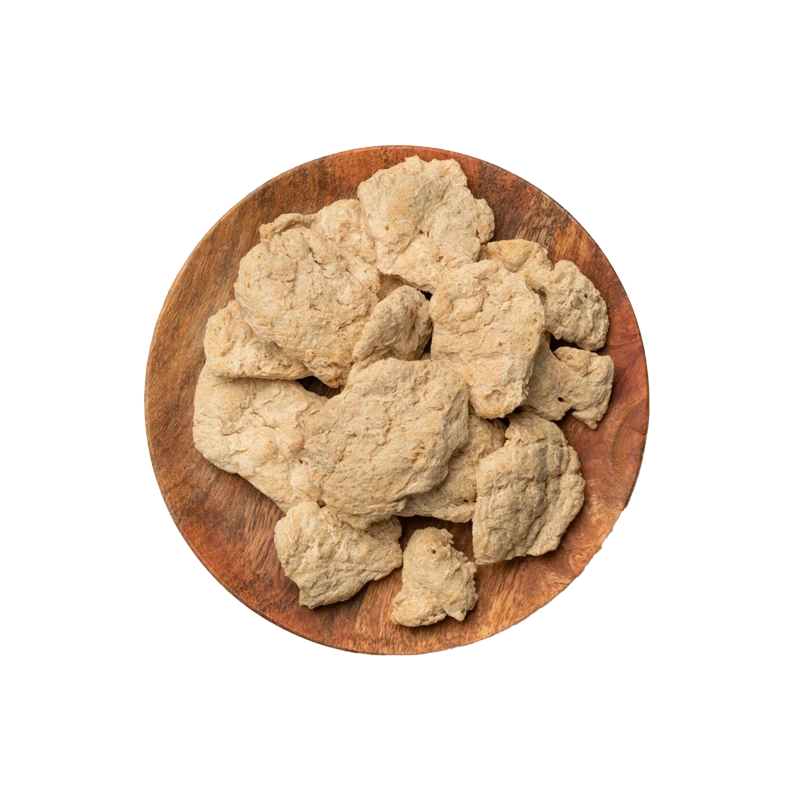Soy Cutlets — Nutrients, Health Benefits, And Shopping Tips

Written by Listonic Team
Last update on September 4, 2024
Soy cutlets nutrients
Nutrition facts
Amount per 100 g
Calories
🔥 290 kcal
| Nutrition per: 100 g | Value | % Daily Value* |
|---|---|---|
| Carbs | 20 g | 7.27% |
| Fiber | 15 g | 53.57% |
| Sugars | 7 g | 14% |
| Glycemic Index | 15 | - |
| Protein | 52 g | 104% |
| Sodium | 20 mg | 0.87% |
| Total Fat | 1 g | 1.28% |
*The % of Daily Value (DV) tells you how much a nutrient in a serving of food contributes to a daily diet. 2,000 calories a day is used for general nutrition advice.
52 g
💪 High Protein Content
15 g
✅ High Fiber Content
Soy cutlets facts & tips
Health benefits
- High in plant-based protein, making them an excellent source of protein for muscle growth and repair.
- Contains essential vitamins and minerals such as iron, calcium, and B vitamins, which support overall health and well-being.
- Rich in fiber if made with whole soybeans, promoting digestive health and regular bowel movements.
- Cholesterol-free, making them a heart-healthy option compared to animal-based protein sources.
- May contain isoflavones, which have antioxidant properties and may support heart health and reduce the risk of certain cancers.
Health risks
- High sodium content in some commercial soy cutlets, which can contribute to hypertension and increased cardiovascular risks when consumed frequently.
- Potential for allergic reactions in individuals with soy allergies, causing symptoms like itching, swelling, difficulty breathing, or anaphylaxis.
- Potential for digestive discomfort such as bloating or gas in some individuals, particularly those sensitive to soy or high-fiber foods.
- Potential for overprocessing in some soy cutlets, leading to a product that is far removed from whole, natural foods, which may impact overall dietary quality.
How to choose soy cutlets
Soy cutlets should have a firm texture that mimics meat, providing a satisfying chew when prepared. The cutlets should maintain their shape during cooking and absorb flavors well.
Avoid soy cutlets that are overly hard or have an off smell, as they may be old or of inferior quality. Packages that are not sealed properly or show signs of freezer burn should also be avoided, as they can affect the taste and texture.

How to store soy cutlets
Soy cutlets should be stored in the refrigerator, preferably in their original packaging or an airtight container. Refrigeration maintains their texture and flavor for up to a week.
Air exposure can cause soy cutlets to dry out and spoil. Avoid leaving them uncovered or near strong-smelling foods. Always ensure the container is tightly sealed to keep them fresh and prevent contamination.
✅ Extra Tip
How long do they last?
Soy cutlets can last for 6-12 months unopened when stored in a cool, dark place. Once opened or prepared, they should be refrigerated and used within 3-5 days. For longer storage, soy cutlets can be frozen for up to 2-3 months.
What to do with leftovers?
Leftover soy cutlets can be used in a variety of savory and plant-based dishes. Slice them and add to stir-fries, salads, or grain bowls for a protein-rich boost, or mix them into a pasta dish with your favorite sauce. Soy cutlets are also great when used as a filling for sandwiches or wraps with fresh vegetables and spreads.
Use soy cutlets in a casserole with potatoes, cheese, and a creamy sauce, or mix them into a stew or chili with beans, vegetables, and spices. If you have a lot of soy cutlets, consider making a batch of soy cutlet sliders with your favorite toppings, or using them as a topping for pizzas or flatbreads. Soy cutlets can also be crumbled and added to a stir-fry with vegetables and a savory sauce, or used as a base for a grain salad with quinoa, farro, or couscous. For a quick snack, enjoy soy cutlets with a dipping sauce or on a bed of greens with a tangy vinaigrette.
👨⚕️️ Medical disclaimer
Discover products from other categories
Listonic Team
Fact-checked
Our editorial team checked this article to make sure it was accurate at the time of publishing it.
Get the top-rated shopping list app on your phone!







